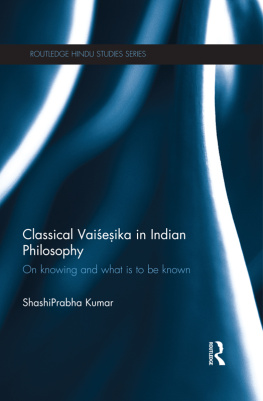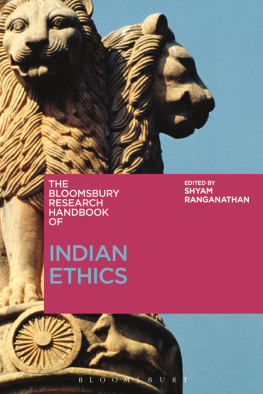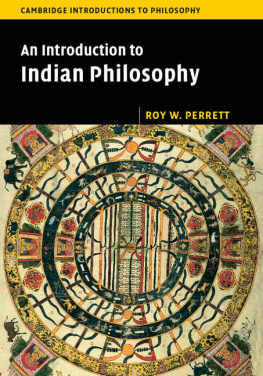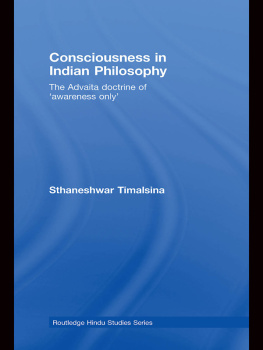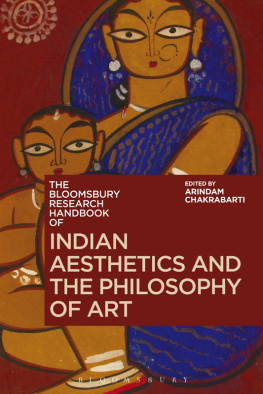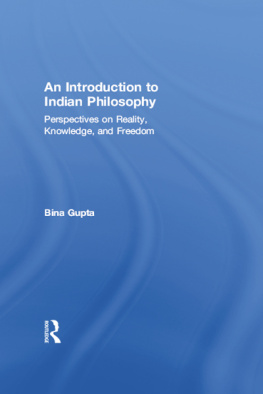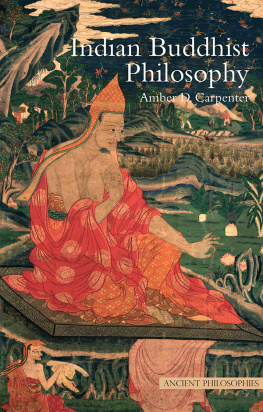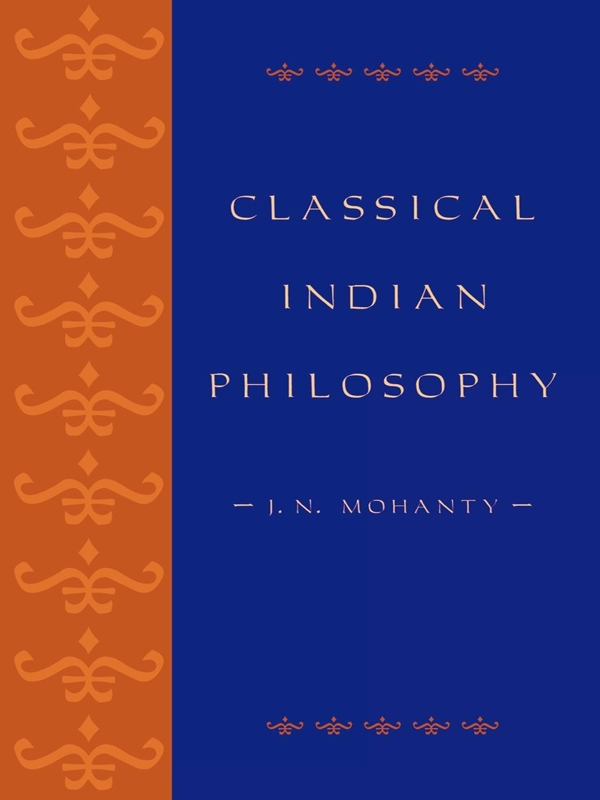Appendix One
A Note on Navya-Nyya Analysis of Cognition
The Navya-Nyya system developed out of the old (i.e., classical Nyya). Its founder is Gangeas Updhyya of the twelfth century. The Navya-Nyya developed a highly technical language, which was most effectively used to formulate and solve problems in logic and epistemology. After the discussion of theory of knowledge (Part 1 ), it may be appropriate to present a brief account of the Navya-Nyaya analysis of cognitionsa sort of analysis that was employed by philosophers of different schools to their own advantage.
First of all, the analysis that will be presented, in very general outlines (leaving out many, many levels of sophistications), holds good only of cognitions that are expressible in languagefor example of conceptual, judgmental, and linguistic perceptions ( savikalpa pratyaka ) , of inferences as well as of word-generated ( abda ) cognitions.
Even if the cognitions to be analyzed are said to be linguistically expressible, the Navya-Nyya does not hold that the cognitions themselves are linguistic. The cognitions are rather guas (qualities which are also occurrent events of the knowing self) as has been explained earlier in chapter 2. Although linguistically expressible, on the Navya-Nyya theory, there would always and necessarily be components of a cognition that are not mentioned (i.e., are anullikhita). For example, if my cognition of that thing in front of me is expressed in that pot, the cognitive component pot has an unmentioned qualifier potness whose presence is understood even if not expressed. However, on the Navya-Nyya theory, only relations, as components of a cognition, cannot be expressed; for, if expressed, they become terms. Thus in the cognition that blue lotus, the relation between blue and lotus, which, on the Nyya theory, is inherence ( samavya ), is not expressed, but is nevertheless understood.
When Navya-Nyya gives an analysis of the structure of the cognition that blue lotus, the expression that analyzes it is not the same as the expression of the cognition. The analysis is carried out on the basis of a reflective focusing on the cognition and with the help of a meta-language that uses technical expressions adapted to the structural components that are discovered in the original cognition.
Analysis of a cognition is not analysis of the object in the ontological mode, but rather of the content in an epistemological mode. All these epistemological contents can be brought under one category, namely, viayat or objecthood. We shall not, for our limited purpose, discuss the question whether this epistemological entity called viayat is identical with the object or is identical with the cognition or is a relation between the twoa topic to which the great logician Gaddhara Bhattacharyya devoted his work viayatvda (Theory of Objectivity). If I have a cognition of a pot, one can say that an epistemic content refers to a pot: the Navya-Nyya prefers to say there is a viayat that attaches to the pot ( ghata-niha ) .
Epistemic contents are of three kinds: viyat or qualificandumness, prakrat or qualifierness, and samsargata or relationness. According to Navya-Nyya, all linguistically expressible cognitions have, to begin with, these three contents. The cognition expressed by that blue lotus then has the following components ( viayats ):
- a qualificandumness attaching to lotus,
- a qualifierness attaching to lotusness,
- a qualifierness attaching to blue,
- a qualificandumness attaching to blue,
- a qualifierness attaching to blueness,
- a qualifierness attaching to that,
- a qualificandumness attaching to that, and
- a qualifierness attaching to that-ness.
Eight qualifies 7; 7, so qualified, qualifies (hence 6) the lotus (1). Five qualifies 4; 4, as so qualified, serves as a qualifier of the lotus (1). The qualificandum in (1) is also qualified by lotusness as in (2). All these entities thus form a relational whole (the relations relating these entities have to be epistemological relations, not ontological relations). A full expansion would thus be a string of names for these epistemological contents, making use of two epistemic relations: limitor-limited ( avacchedaka-avacchinna ) and nirpaka-nirpita (determinant-determined). All these contents, appropriately related and nested into each other, would in the long run qualify the cognition (being analyzed), which again must be located in the knowing subjects self. A brief, highly simplified, example would be: The cognition (located in the self of S) whose qualificandum is lotus as qualified by lotusness, and thatness ( tatta ), the qualifier of which is the blue color as qualified by blueness, and the relation by which the lotus is qualified by blue is the relation of inherence.
Appendix Two
Some General Features of the Indian Theories of Knowledge
- The Indian epistemologies are through and through causal theories. The pramas are defined, as we have seen, as what cause the true cognitions. The distinction, common in Western thought, between the causal question and the question of justification, was not made by the Indian theories. True cognition is said to be not only what corresponds to its object, but also is produced in the right way. This would be a way of avoiding the so-called Gettier paradoxes.
- The methods that the theorist generally applies, both while defending her own position and critiquing her opponent are: (i) appeal to ordinary linguistic usage ( lokavyavahra ); (ii) consider the evidence of experience, ordinary as well as not-so-ordinary; (iii) and, finally, consider the evidence of ones own introspection into ones cognitive life. Thus, while analyzing a cognition, the Navya-Nyaya appears to be analyzing the linguistic expression of the cognition, while all the while we are asked to check the validity of the analysis by looking at the introspective data. So we can say that the Indian epistemologist gives a theory of cognition, not merely of linguistic expression of cognitions, nor of what the Western logicians call propositions. This is particularly striking in the case of Indian theories of inferential cognition.
- Cognition is also looked upon by the Indian theorist as leading to conative activity. A cognitive theoryas, for example, in the case of theories of false cognitionis tested by its ability to account for appropriate conative response.
- Connected with (2) above is the fact that all Indian theories of meaning (of words and sentences) are referentialwith the sole exception of the Buddhist theory of apoha. A word means what it designates. A sentence means a complex state of affairs. Consequently, the meaningfulness of empty terms such as sky flower and of false sentences remained problematic. The former was accounted for by the Nyya in a manner reminiscent of Russells theory of descriptions. The latter proved recalcitrant to the theory of abda as a means of knowing, discussed earlier in chapter 2.
- Perhaps the emphasis laid on abda as a prama (i.e., on knowledge that is generated by words alone), is a distinctive feature of the Indian epistemological theories. The idea also serves them well to give an account of our moral knowledge (i.e., of knowledge of what one ought and ought not to do).
- Logic, as theory of inference, is a part of theory of knowledge. The Indian logicians interest is in inference as a mode of knowing. As noted before, logic remains a logic of cognition. Consequently it remains in the vicinity of a psychology of inference. Yet the ruinous consequences of psychologism are avoided by showing how, in the absence of specific faults ( doas ) , the psychological process leads to logically valid conclusions. If logic is psychologized, one may say, so is psychology logicized. The psychological process of inference and the logically valid structure coincideat least insofar as first-order logic is concerned. Besides, one should note that inasmuch as the logic is concerned with cognitions and uses the language of properties and limitors (in place of quantification), it is intensional. But insofar as it presupposes a purely referential theory of meaning, it is extensional.


